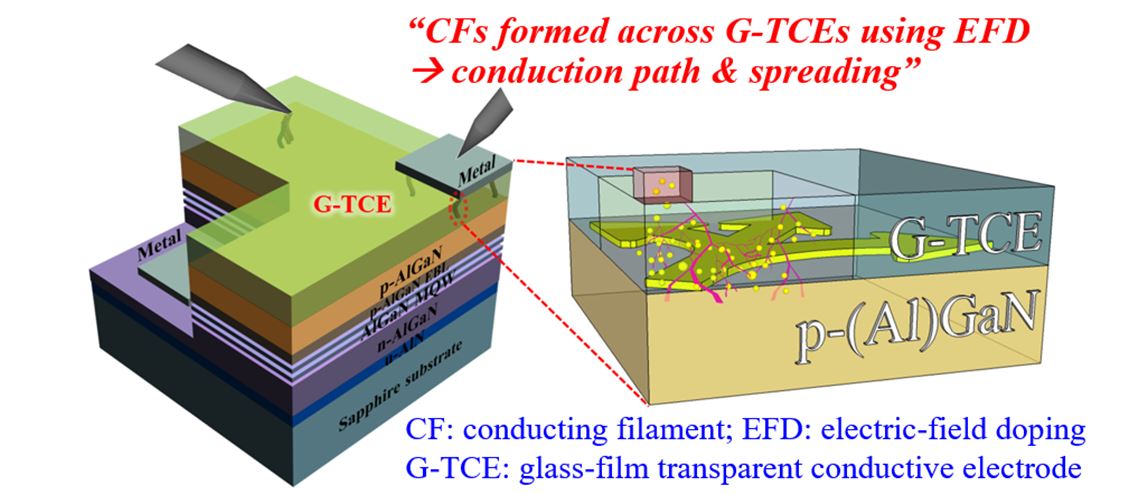Video Article Open Access
Efficiency Breakthrough for Nitride-Based Blue and UV LEDs using Electrically Metal-Doped Glass-Film Electrodes
K. R. Son1, T. H. Lee1, Y, T. H. Park1, H. Hirayama2, Tae Geun Kim1,*
1School of Electrical Engineering, Seoul 02841, Korea University, Korea
2Institue of Physical and Chemical Research Center, RIKEN, Saitama, Japan
Vid. Proc. Adv. Mater., Volume 2, Article ID 2021-02113 (2021)
DOI: 10.5185/vpoam.2021.02113
Publication Date (Web): 21 Mar 2021
Copyright © IAAM
Graphical Abstract

Abstract
Modern optoelectronic devices, including organic/inorganic solar cells and light-emitting diodes (LEDs), require ultra-thin electrodes with a high electrical conductivity and wideband optical transparency [1,2]. However, most conventional transparent conductive oxides (TCOs) are fragile and electrically n-type materials with limitations with respect to their thickness, UV transparency, and work function (WF) tuning. These limitations impede the band alignment and charge balance when TCOs are used in a p-electrode [2]. Therefore, there has been a significant increase in the demand for the successful tailoring of the WF in conventional ultra-thin TCOs without compromising their innate electrical and optical characteristics.
To cope with these issues, we have proposed an electrically metal-doped glass-film electrode with high transmittance, low resistance and properly-tuned work function. For instance, Ni-doped ultrathin ITO films exhibited significantly low resistance and high transmittance. Furthermore, work function values of such a Ni-doped ultrathin ITO have changed from 4.7 to 5.3 eV with an increase in Ni dopants, facilitating hole transport into the device active region. Similar changes were observed for other TCOs such as aluminium-doped ZnO and fluorine-doped SnO films to show the universality of the method. Finally, the proposed method is validated by applying these films to blue and UV light-emitting diodes. This method offers a new paradigm for developing highly transparent and low-resistant TCOs to bring efficiency breakthroughs in traditional photonic devices.
Keywords
Glass-film electrode; transparent conductive electrode; light-emitting diode; work function tuning.
Acknowledgement
This work was supported by the National Research Foundation of Korea (NRF), Ministry of Science, ICT & Future Planning (grant number 2016R1A3B1908249).
References
- F. Yan, X. Zhang, G. Y. Yonggang, L. Yu, A. Nagaraja, T. O. Mason, A. Zunger, Nat. Commun., 2015, 6, 7308.
- G. Hautier, A. Miglio, G. Ceder, G. M. Rignanese, X. Gonze, Nat Commun., 2013, 4, 2292.
- H. D. Kim, H. M. An, K. H. Kim, S. J. Kim, C. S. Kim, J. Cho, E. F. Schubert, T. G. Kim, Adv. Funct. Mater., 2014, 24(11), 1575.
- K. R. Son, T. H. Lee, B. R. Lee, H. S. Im, T. G. Kim, Small, 2018, 14(49), 1801032.
- T. H. Lee, T. H. Park, H. W. Shin, N. Maeda, M. Jo, H. Hirayama, B. Kim, T. G. Kim, Adv. Opt. Mater., 2020, 8(2), 1901430.
Biography
T.G. Kim received the B.S., M.S., and Ph.D. degrees from Korea University, Seoul, Republic of Korea in 1990, 1993, and 1997, respectively, all in Electronics Engineering. From 1997–2002, he was with the Department of Electrical and Computer Engineering, University of California San Diego, La Jolla, as a Postdoctoral Fellow, the Electron Device Division of Electrotechnical Laboratory, Japan, as a New Energy and Industrial Technology Development Organization Fellow, and the MD Laboratory, Samsung Advanced Institute of Technology, Suwon, Korea, as a Principal Research Scientist. He is currently with the School of Electrical Engineering, Korea University. His current research interests include electrical/optical semiconductor materials and devices and their applications to nonvolatile memory devices, optical devices (i.e., OLEDs, micro-LEDs, OPVs) and micro/nano electrical sensors and devices. So far, he has authored and coauthored more than 320 SCI journal papers, filed/registered over 200 patents, and received over 50 academic awards.
Video Proceedings of Advanced Materials

Upcoming Congress



